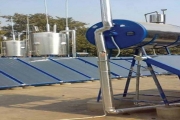/regions/india
India
Can India be firm with China on Brahmaputra dams ? - An article by Himanshu Thakkar
Posted on 20 Dec, 2010 02:34 PMForwarded to the Portal by: Himanshu Thakkar
Article and Image Courtesy: SANDRP
Author: Himanshu Thakkar
Chinese Premier Wen Jiabao’s forthcoming India visit (15-17 Dec 2010) provides another useful opportunity for India to be firm and forthright with China on India’s concerns about Chinese dam and hydropower projects on the shared rivers, including in the Brahmaputra basin. The importance of this issue cannot be underscored considering that this issue has been raised in the Parliament several times, even the Prime Minister has had to make clarifications in the recent past, the people and governments of several states, including Assam and Arunachal Pradesh have been agitated about this. India’s Planning Commission, Environment, Water Resources and Power Ministries have also been raising these concerns.
ACWADAM’s certificate course on training and facilitation in hydrogeology to enhance civil society capabilities in watershed and groundwater management
Posted on 20 Dec, 2010 12:29 PM Organizer: Advanced Center
Organizer: Advanced Center
Understanding groundwater - A course by ACWADAM
Posted on 20 Dec, 2010 01:01 AMThe Advanced Centre for Water Resources Development and Management (ACWADAM) has created a power-point course to explain the formation of groundwater and its management.
The course consists of 6 modules; it includes the basics of understanding groundwater, study of geology, groundwater level and movement, planning and management of groundwater, storage and flow of groundwater and water quality. The modules have been made into succinct power-point presentations that include charts, diagrams and photographs besides the written word.
Review of current practices in determining user charges & incorporation of economic principles of pricing of urban water supply
Posted on 19 Dec, 2010 07:21 PMThis paper is an outcome of The Energy Research Institute's (TERI’s) study for the Ministry of Urban Development (MoUD) under the Ministry’s Centre of Excellence (COE) to “Review the existing guidelines of determination of user charges for water and sanitation services and to incorporate economic principles of pricing in urban water supply sector in India”.
Transdisciplinary method for water pollution and human health research – A working paper by Peter Mollinga
Posted on 19 Dec, 2010 06:21 PMThis paper discusses how to go about designing an interdisciplinary or transdisciplinary research project or programme, with ZEF’s research initiative on ‘water pollution and human health’ in India as the background of the presentation. A summary is given of Pohl and Hirsch Hadorn’s main arguments regarding ‘design principles’ for inter- and transdisciplinary research, and the basic tools they have developed for this are discussed in the context of ZEF’s ‘water pollution and human health’ research initiative.
International Rivers is looking for Executive Director
Posted on 18 Dec, 2010 12:17 PMContent and Image Courtesy: International Rivers
International Rivers is accepting applications for the position of Executive Director. International Rivers seeks a proven, passionate, and dynamic Executive Director who has a keen sense of the urgency of the threats to rivers and communities – as well as the need for sustainable solutions – and is ready to take on this challenge with enthusiasm, strategic vision, creativity, and bold tactics.
Conceptual framework of South Asian water futures exchange - Commodity Vision
Posted on 18 Dec, 2010 12:15 AMIn this article published in Commodity Vision, the author presents the concept of the establishment of a 'futures market in water availability' in the context of the risk of water availability that Indian agriculture has been facing in the recent years.
With South Asian agriculture being dependent on the timely occurrence of the monsoons, any deviation from the scheduled arrival of the monsoon causes problems not only for the farmers, but also produces a threat to the food security of the region. However, the author argues that, there is no market in South Asia where users and investors exposed to water availability risk can effectively hedge against such a risk.
Mine the gap: Connecting water risks and disclosure in the mining sector – A report by the World Resources Institute
Posted on 17 Dec, 2010 10:43 PMThis paper by the World Resources Institute outlines potential water-related risks facing the mining industry and highlights important gaps in water-related disclosure. The purpose is to provide information, questions, and tools to help the financial community better evaluate water-related risks facing mining companies.
Water management across space and time in India – A working paper by the University of Bonn
Posted on 17 Dec, 2010 10:09 PMThis working paper by the University of Bonn attempts to give a spatial and temporal overview of water management in India. It traces how people and the successive regimes made choices across space and time from a wide range of water control and distribution technologies. The paper divides the water management in India into four periods –
- the traditional system of water management before colonial times;
- response from the colonial rulers to manage the complex socio-ecological system;
- large scale surface water development after independence; and
- finally, the small-scale community and market-led revolution.
Users handbook on Solar Water Heaters by the Ministry of New and Renewable Energy
Posted on 17 Dec, 2010 07:56 PM This user’s handbook on Solar Water Heaters by the Ministry of New and Renewable Energy (MNRE) in collaboration with the UNDP/UNEP/GEF Global Solar Water Heating Market Transformation Strengthening Initiative attempts to transform the solar water heating market in India.
This user’s handbook on Solar Water Heaters by the Ministry of New and Renewable Energy (MNRE) in collaboration with the UNDP/UNEP/GEF Global Solar Water Heating Market Transformation Strengthening Initiative attempts to transform the solar water heating market in India.